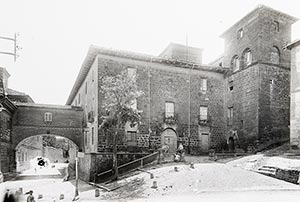House of the Mencos de Tafalla
By Ignacio Miguéliz Valcarlos
|
|
|
|
|
|
|
|
|
|
|
|
|
|
|
|
|
|
|
|
|
|
|
|
|
|
Introduction
The arrival of the Mencos family in Tafalla took place around 1420, when Don Martín de Mencos y Ollauri settled in the town, in a house located near the church of Santa María. It was in the last quarter of the 16th century, around 1580, when the Mencos began the construction of a new house on land purchased outside the city walls, near the Olite gate of the walls of Tafalla and next to the Camino Real. The building was erected on a small hill, on slightly sloping land.
The house remained the Mencos' main residency program for two centuries, from the time of its construction until 1770, when the family moved to Pamplona. This building witnessed the social rise of its owners: Thus, in 1651, Philip IV granted them the position de justicia y alcaides perpetuos de los Reales Alcázares de Tafalla; in 1696, Don José Sebastián Mencos y Ayanz de Navarra (1678-1750) married Doña Basilia Ayanz de Navarra Arbizu Lodosa (1682-1757), Countess of Guendulain and Baroness of Bigüezal, these titles being linked to the surname Mencos; and finally, in 1770, Don Joaquín José Mencos y Areyzaga (1748-1817) married Magdalena de Eslava y Eslava (1746-1819), Marquise de la Real Defensa and Countess of Fresno de la source, which meant the family moved to Pamplona, to the palace of Guendulain, built by the Marquises de la Real Defensa, and the conversion of the house of Tafalla into a secondary residency program .
The recovery and restoration of the house as residency program de los Mencos took place during the 1940s, under the guidance of Tiburcio Mencos y Bernaldo de Quirós (1891-1969), Marquis of Real Defensa, who restored the house to its original splendour, a task that has been continued by his son, Joaquín Ignacio Mencos y Doussinague (1944).
Throughout its history, the house has suffered various vicissitudes that have shaped its current appearance. Between 1810 and 1813, during the War of Independence, it was occupied by French troops under the command of Marshal Moncey, being burnt down in 1813 on the orders of the guerrilla Francisco de Espoz y Mina so that it would not serve as a defensive bastion for the enemy, leaving only the exterior walls and the tower attached to the façade standing. Once the house was finished, it was rebuilt in 1816 on the initiative of the Count of Guendulain, Joaquín José Mencos y Areyzaga (1748-1817), and his son, Joaquín María Mencos y Eslava (1771-1852), who requested plans from the Madrid architect Pedro Nolasco Ventura. During the First Carlist War (1833-1839) it was the headquarters of the Christian troops, supporters of Isabella II. In 1875, in the context of the Third Carlist War (1873-1876), it became the hospital of the Humanitarian Society for the Relief of the Wounded, the forerunner of the Red Cross, the first of its kind in Spain. Finally, during the Spanish Civil War (1936-1939), it was a school for non-commissioned officers and barracks for the Civil Guard.
GARCÍA GAINZA, M.ª C. et al., Catalog Monumental de Navarra. Volume III. Merindad de Olite, Pamplona, Government of Navarra, 1985.
GONZÁLEZ VARAS, I., Palacios y casas señoriales de España: un recorrido a través de su historia y de sus propietarios, Madrid, Turner, 2018.
MENCOS ARRAIZA, J. I., Estudio genealógico y heráldico de la Casa de los Mencos de Tafalla, Tafalla, Mencos Foundation, 2020.
MIGUÉLIZ VALCARLOS, I., "Nuestra Señora de la Soledad", "Cristo de Santa Teresa", "Inmaculada Concepción" and "Virgen del Carmen", in GARCÍA GAINZA, M.ª C. and FERNÁNDEZ GRACIA, R. (coords.), Juan de Goyeneche y el triunfo de los navarros en la monarquía hispánica del siglo XVIII, Madrid-Pamplona, Fundación Caja Navarra, 2005.










